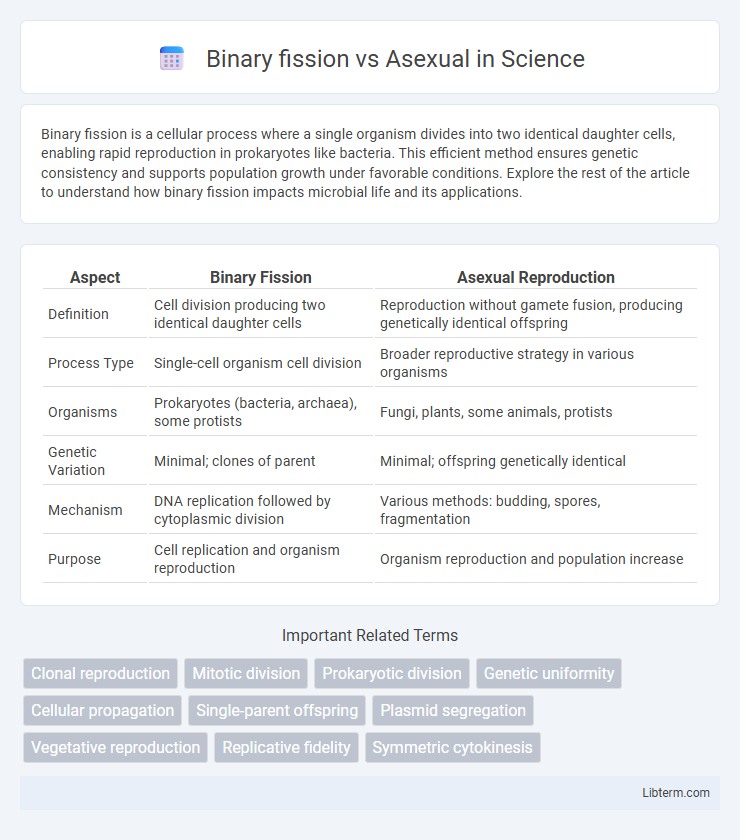Binary fission is a cellular process where a single organism divides into two identical daughter cells, enabling rapid reproduction in prokaryotes like bacteria. This efficient method ensures genetic consistency and supports population growth under favorable conditions. Explore the rest of the article to understand how binary fission impacts microbial life and its applications.
Table of Comparison
| Aspect | Binary Fission | Asexual Reproduction |
|---|---|---|
| Definition | Cell division producing two identical daughter cells | Reproduction without gamete fusion, producing genetically identical offspring |
| Process Type | Single-cell organism cell division | Broader reproductive strategy in various organisms |
| Organisms | Prokaryotes (bacteria, archaea), some protists | Fungi, plants, some animals, protists |
| Genetic Variation | Minimal; clones of parent | Minimal; offspring genetically identical |
| Mechanism | DNA replication followed by cytoplasmic division | Various methods: budding, spores, fragmentation |
| Purpose | Cell replication and organism reproduction | Organism reproduction and population increase |
Introduction: Understanding Binary Fission and Asexual Reproduction
Binary fission is a type of asexual reproduction where a single organism divides into two genetically identical daughter cells, commonly observed in prokaryotes like bacteria. Asexual reproduction encompasses various methods, including binary fission, budding, and spore formation, enabling organisms to reproduce without genetic recombination. Understanding binary fission provides key insights into rapid population growth and genetic consistency in asexual organisms.
Defining Binary Fission: A Special Type of Asexual Reproduction
Binary fission is a specific form of asexual reproduction primarily observed in prokaryotic organisms such as bacteria, characterized by the direct division of a single parent cell into two genetically identical daughter cells. This process involves the replication of the organism's DNA, followed by the invagination of the cell membrane and cytoplasmic division, ensuring rapid population growth without genetic variation. Unlike other asexual reproduction methods, binary fission does not involve formation of specialized reproductive structures or spores, making it a streamlined mechanism for cellular proliferation.
What is Asexual Reproduction? Key Features and Types
Asexual reproduction is a biological process where offspring arise from a single organism without the involvement of gamete fusion, ensuring genetic uniformity. Key features include rapid population growth, no genetic variation, and inheritance of traits identical to the parent. Common types of asexual reproduction encompass binary fission, budding, spore formation, and vegetative propagation.
Key Differences Between Binary Fission and Other Forms of Asexual Reproduction
Binary fission is a simple, rapid form of asexual reproduction primarily found in prokaryotes like bacteria, where a single cell divides into two genetically identical daughter cells. Unlike other asexual methods such as budding, fragmentation, or spore formation commonly seen in eukaryotes, binary fission involves equal partitioning of the parent cell's cytoplasm and DNA. Key differences include the organism types involved, the complexity of the process, and the method of genetic material distribution, with binary fission being the most direct and efficient form of asexual reproduction.
Biological Examples: Binary Fission in Bacteria vs. Asexual Reproduction in Plants and Animals
Binary fission, a common form of asexual reproduction in bacteria such as Escherichia coli, involves the division of a single cell into two genetically identical daughter cells. In contrast, asexual reproduction in plants and animals, including methods like vegetative propagation in strawberries and parthenogenesis in certain reptiles, results in offspring genetically identical to the parent without the union of gametes. These processes highlight distinct mechanisms of organismal replication across biological domains, emphasizing cellular division in prokaryotes and diverse reproductive strategies in eukaryotes.
Genetic Implications: Clonal Offspring and Variation
Binary fission results in clonal offspring with identical genetic material to the parent, leading to minimal genetic variation within the population. In contrast, asexual reproduction encompasses various mechanisms, such as budding and fragmentation, which also produce genetically identical clones but may allow for occasional mutations contributing to slight variation. Both processes limit genetic diversity compared to sexual reproduction, impacting adaptability and evolution over time.
Process Comparison: Steps of Binary Fission vs. Asexual Modes
Binary fission involves a single organism dividing into two identical daughter cells through DNA replication, chromosome segregation, and cytoplasmic division. Asexual reproduction includes diverse modes such as budding, fragmentation, and spore formation, each with distinct steps like producing a bud or breaking into parts, rather than the direct cell division seen in binary fission. The process of binary fission is more streamlined and specific to prokaryotes, whereas asexual reproduction encompasses various mechanisms across multiple organisms.
Evolutionary Advantages and Disadvantages
Binary fission, a rapid and efficient asexual reproduction method primarily seen in prokaryotes like bacteria, allows for quick population growth and genetic stability but limits genetic diversity, making populations vulnerable to environmental changes. Asexual reproduction, encompassing methods such as budding, fragmentation, and spore formation, offers evolutionary advantages like energy conservation and reproductive assurance in the absence of mates but suffers from reduced adaptability compared to sexual reproduction. Both processes promote survival in stable environments but disadvantage organisms under shifting conditions due to decreased genetic variation necessary for evolutionary resilience.
Environmental Factors Influencing Reproductive Methods
Environmental factors such as nutrient availability, temperature, and population density significantly influence binary fission in prokaryotes, enabling rapid reproduction under optimal conditions. Asexual reproduction methods in multicellular organisms are often triggered by stressors like drought or extreme temperatures, promoting survival through genetic stability. Both reproductive strategies optimize offspring production by responding to environmental cues that affect resource allocation and organismal health.
Conclusion: Choosing Between Binary Fission and Asexual Reproduction
Choosing between binary fission and asexual reproduction depends on the organism's complexity and environmental conditions, as binary fission is a simpler, rapid division method typical in prokaryotes, while asexual reproduction encompasses diverse mechanisms like budding and spore formation in eukaryotes. Binary fission offers quick population growth with genetically identical offspring, whereas broader asexual reproduction methods allow adaptability and survival in varied habitats. Understanding these processes aids in biological research, biotechnology, and evolutionary studies by highlighting reproductive strategies and organismal resilience.
Binary fission Infographic

 libterm.com
libterm.com